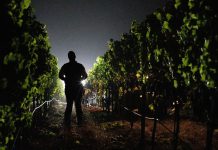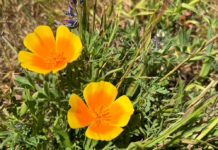Renee Kiff
Bees are one of the most amazing creatures on the planet, equal
only to the remarkable folks that keep them. I’ve had the
delightful and educational experience of interviewing some in the
beekeeping world for an article in the Life Style Magazine but, I
was limited to a certain number of words. (Thank heaven, thinks the
reader.) Some of my favorite notes ended up edited out by me. So, I
am going to devote this column to some of the “editions.”
Julie Dilley, a home beekeeper from Cloverdale, could have been
the subject of the entire article, rather than one-fourth. Picture
a young Meryl Streep, tall, curly hair, so comfortable in her own
persona that even a swarm of bees would find her unthreatening.
A swarm is a group of bees with a queen and often 60 percent of
the hive, who have left the comforts of home due to congestion or
disease. They will readily allow themselves to be transferred to a
new hive box but usually need the assistance of a beekeeper to make
that location change.
Julie showed me the accoutrements of a bee box — the honey comb
and wax, the frames, the hive tool. For every need there is an
answer, usually. If the entrance to the hive is under attack, there
is a small board that reduces the entrance size, so that a smaller
number of defending bees can succeed.
What threatens the hive? Wasps attack honey bee hives to eat the
young larvae. Wasps are carnivores while honey bees are
vegetarians. Any time a “bee” is after your barbequed chicken, it
isn’t a bee – it’s a wasp. Yellow jackets are wasps. Tragically,
honey bees have no defense against tiny mites called Varroa and
Trachial which, in the nineties, wiped out thousands of hives.
Some interesting facts from Julie Dilley:
The honey bee must tap about two million flowers to make one
pound of honey and a hive of bees flies more than 55,000 miles to
do that. (Yes, three zeroes)
Worker bees visit 50-100 flowers during each trip to gather
nectar.
There are an estimated 150,000 hobby beekeepers in the USA.
Worker bees, all female, live only five weeks. Inside the hive
for the majority of those weeks, they tend both larvae and queen,
clean cells, fan the hive to keep it cool as well as to dehydrate
the nectar, defend the hive’s entrance, clear out any dead bees.
They then spend their last two weeks as field foragers. Beating
their four tiny wings at 15 miles per hour, they will work
themselves to death, often experiencing torn or frayed wings from
encounters with yellow star thistle.
One of the most amazing facts from Julie’s trivia sheet is “How
do honey bees ‘communicate’ with one another?
They communicate by ‘dancing.’ This alerts other bees where
nectar and pollen are located. The dance explains direction and
distance. Bees also communicate with pheromones, a unique odor
common to the particular beehive.”
What can we, home gardeners and farmers, do to make bee’s life
easier or, at least, not so dangerous? The primary act would be to
read labels and stop using killer pesticides. It turns the bees’
life source, nectar, into toxic food.
Ground herbicide spraying is also terrible for our native bumble
bees who do not live in social hives like the honey bee. Bumble
bees live in small holes in the ground, perhaps ones vacated by a
gopher, or in pieces of pipe, old wood, hollowed plant stems.
Though they don’t produce large resources of honey, they are some
of our best pollinators.
Next, include in our gardens what bees need, particularly early
spring and fall flowering plants, when summer’s abundance isn’t
present. A partial list of native flowers (from Plant a Bee Garden
by kerryg) might include: Aster, Penstemon, Monarda, Rudbeckia,
Goldenrod, Lobelia, Sage, Coreopsis, Yarrow, Daisy, Lavender, Mint,
Dahlia, Zinnia, Cosmos. Shrubs and trees include: Barberry,
Currant, Elder, Redbud, Rhododendron, Viburnum, Wild lilac, Wild
rose, Willow.
GardenGuides.com lists
Sedum as very important as it blooms in autumn. It has many virtues
for California gardens. Both heat and drought tolerant, it can
easily be divided into more plants after one season, filling your
garden with sturdy flowers when all else is looking tired,
including the gardener. This plant may require some staking, as it
bends down when watered overhead.
Borage is a family favorite of bees and will reseed readily. The
bees like this feature but picky gardeners may not. Give it lots of
room and you won’t mind its lovely purple/blue flowers cropping
up.
Tulip Tree, a relative of the magnolia, is another favorite and
its early bloom saves many a bee from an otherwise disappointing
field assignment.
Next time a honey bee lands on your hand, count those four
little wings and be glad they are still in good flight shape. Teach
yourself and those in your world to just provide a gentle breath of
air, no frantic arm waving and never a smack, to send Miss Bee on
her way to the next flower. Her short life is indispensable for her
world and ours.
Renee Kiff weeds and writes at her family farm in Alexander
Valley.








